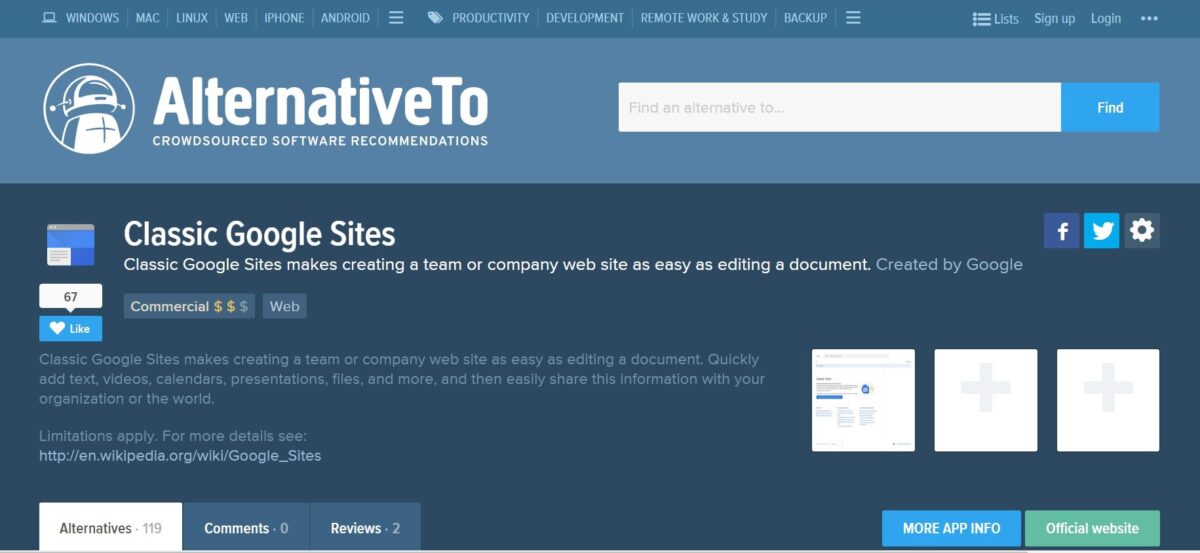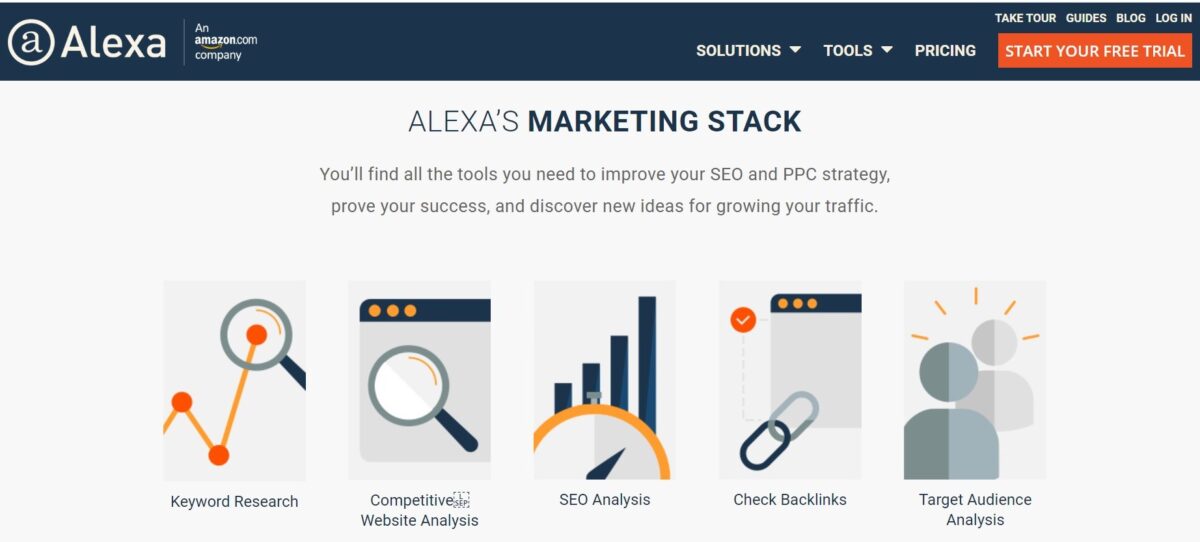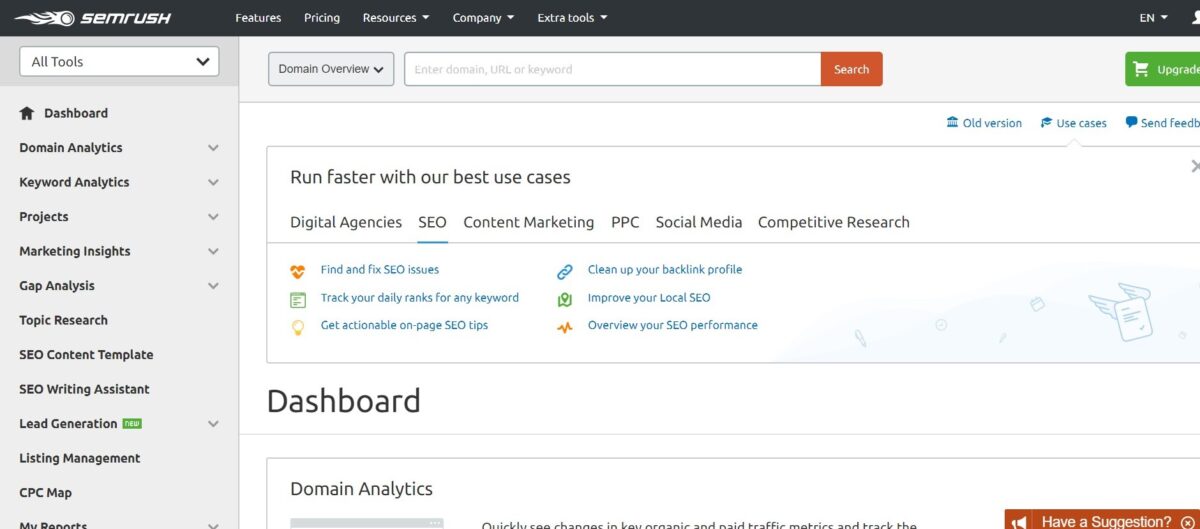In our free market economy, it's clear that some businesses will prosper more than others. As you go about your day-to-day activities, you might notice that some businesses are succeeding while others aren't. This often comes down to businesses making mistakes without even realizing it. But what if you're the one making those mistakes? How can you identify them and get back on track?
A website competitive analysis can help you uncover these insights. It provides insights on both opportunities for improvement and potential threats to your business. It is one of the best ways to get to know your competitors, what they are thinking about the market, which tactics they are using, and what they are up to.
However, it’s not as simple as just scoping out your competition. To truly benefit from a competitive analysis of websites, you need to use the right tools and strategies.
Knowing what your competitor is doing can make a difference.
Knowing what your competitor is doing can give you a significant edge. Studies show that 74% of business owners agree that competitive analysis is “important or very important,” yet 57% admit they aren’t very good at conducting it. This article will show you how to analyze competitors’ websites the right way, using competitor marketing analysis software, competitor research tools, and website competitor analysis tools.
Start for free with GoDaddy and create a professional optimized website that'll take your business further, with built-in SEO tools.
What is a website competitive analysis?
Competitive analysis is a broad term for the practice of researching, analyzing, and comparing competitors in relation to yourself. It could be done for a wide variety of aspects like website, branding, marketing strategy and pricing.
A website competitive analysis is analyzing competitors’ websites in relation to yours. It is done through the lens of improving the site’s ability to meet or exceed the competitors’ website.
To get a better idea of your position in the market, you need to know how to compare websites to competitors effectively. With online competitive analysis tools, you can check competitor websites and compare your website with competitors. These tools can help you identify key differences, enabling you to adjust your strategy accordingly.
Companies do it for a wide variety of reasons— website, SEO, branding, go-to-market strategy, pricing, etc.— and you can use it for UX and conversion optimization, too.
There are many techniques that can be used to analyze a website, including:
- Keyword analysis: It is the process of researching the language of your audience so you can be more easily found in search.
- Usability analysis: It is the process of considering how to design and structure your website to meet the needs of a certain demographic. Every redesign should start with a website analysis.
Key elements to analyze in a competitive analysis for your website
How to do competitor website analysis is one important aspect which allows you to assess the content strategy of your competitors and determine where you might be falling short. Similarly, site monitoring competitor analysis helps you track your competitors’ website performance over time, keeping you updated on their latest tactics.
By using website competitor finder tools and conducting competitor website research, you can stay ahead of the competition and continuously optimize your online presence.
Using competitor analysis tools and website analysis software allows businesses to gain insights into their competitors' strategies and identify opportunities to improve their own. Below are the key elements to analyze, along with tools and their capabilities that can help you achieve this:
- SEO (Search Engine Optimization):
- Evaluate on-page and off-page optimization strategies.
- Analyze competitors’ meta titles, meta descriptions, and use of keywords.
- Study the technical SEO aspects such as site speed, mobile-friendliness, and structured data.
- Content Analysis:
- Assess the quality, relevance, and uniqueness of competitors' content.
- Identify high-performing pages and understand their content structure and tone.
- Check for duplicate content issues and keyword density.
- Backlinks:
- Examine the quantity and quality of backlinks pointing to competitors’ websites.
- Identify the sources of high-authority backlinks and domains.
- Analyze anchor text distribution and link-building strategies.
- Social Media Presence:
- Track engagement levels, follower growth, and campaign performance across platforms.
- Understand their posting frequency and the types of content they share.
- Monitor audience feedback and sentiment analysis.
- Keyword Rankings:
- Discover the keywords competitors rank for organically.
- Assess keyword intent (informational, navigational, or transactional).
- Compare ranking positions for shared target keywords.
How to do a website competitive analysis?
A competitor website analysis is an essential strategy for staying ahead in the market. By understanding what your competitors are doing well (or poorly), you can gain valuable insights to improve your own website and business performance. Here’s a step-by-step guide on how to analyze competitors' websites effectively.
1. Identify your competitors
The first step is to identify who your direct competitors are. These are businesses that offer similar products or services in the same market. You can use competitor website research to discover competitors by searching for keywords related to your business and seeing who ranks highly.
Tools like competitor website analysis tools and online competitive analysis tools use tools like Alternativeto or SimialrWeb. can help you identify competitors who are actively targeting the same audience and keywords.

2. Analyze their website structure
Start by reviewing the layout and design of their website. Pay attention to:
- Navigation: How easy is it to navigate their site? Are the main services or products clearly defined?
- User Experience (UX): Is the site user-friendly? Does it load quickly and work well on mobile devices?
- Call to Action (CTA): Are they using strong CTAs to guide visitors through the website?
Tools like comparative website analysis platforms can help you analyze website structure, usability, and performance.
3. Evaluate website content
You will use the keywords throughout the content in your homepage, blog, and pages. Remember your content should be informative, up-to-date, and well organized. It should also give your audience a chance to engage, for example, You can encourage your audience to share your blog posts with clear call-to-actions.
Look at things like the word count of their blog posts, images and infographics used, and how helpful the content is. And try to post longer, more useful, and more engaging content.
When analyzing your competitor’s website, consider:
- Blog Posts and Articles: Are they posting valuable content regularly? How do their blog posts compare to yours in terms of quality and relevance? Use a blog competitor analysis tool to track content performance.
- Product or Service Descriptions: Are their offerings clearly described? How persuasive are they in converting visitors into customers?
- SEO Optimization: Check if their content is optimized for search engines. Look for their use of keywords, meta descriptions, and headings.
Tools like how to do competitor content website analysis can provide insights into how well their content is optimized for search engines.
4. Study your competitor's site traffic and keywords
According to Kissmetrice, 30.5% of online business website traffic comes from search engines, like Google. Keywords are a vital part of your success and your competitors’ analysis.
Know which keywords your competitor uses and then try to rank for similar, popular and profitable keywords. You can also work on words with fewer competitions.
Use competitor web analytics tools to analyze where your competitors are getting their traffic from. Are they relying more on organic traffic, paid ads, or social media? You can also use tools like competitor marketing analysis software to track their keyword performance. This will help you understand what terms they are ranking for and which pages are performing best.
Some tools to consider:
- Competitor research tool (e.g., SEMrush, Ahrefs)
- Competitor website checker for traffic analysis
5. Evaluate their social media and external presence
Your competitor’s social media activity can offer insights into their marketing strategies. Look at:
- Which platforms they are active on (e.g., Facebook, Instagram, LinkedIn)
- Engagement metrics (likes, comments, shares)
- Content strategy (are they promoting offers, sharing blog posts, engaging with users?)
Social media insights can be crucial for understanding how competitors are driving traffic to their websites and engaging with their audiences.
6. Review their backlink profile
People trust websites with a generous number of backlinks. If your competitors have several quality backlinks from authority sites, then you will need to target some of your own authority sites for backlinks.
You can use Long Tail Pro to learn more about your competitors’ backlinks. It shows you how many external backlinks your competitors’ websites have. You can increase your backlinks by pitching authority websites in your industry for guest posts.
7. Check for technical SEO issues
Use a competitor website checker to analyze their technical SEO. This includes factors like:
- Page speed
- Mobile-friendliness
- Secure HTTPS connections
- Structured data implementation
- Crawlability and indexation issues
Tools like Google Search Console or site monitoring competitor analysis tools can help uncover any technical SEO weaknesses competitors might have that you can capitalize on.
8. Track their paid advertising strategies
Many competitors use paid ads to drive traffic. Use tools like competitor marketing analysis software to track the keywords they are targeting and the ad copy they are using. This can provide insights into their advertising budget, goals, and performance.
9. Monitor their updates and changes
Keep an eye on any changes your competitors make to their websites. This could include design changes, new product launches, blog posts, or promotional offers. Tools like site monitoring competitor analysis can help you track these changes and adjust your strategy accordingly.
10. Find out your competitors’ strengths and weaknesses
A thorough analysis will help you identify what your competitors excel at and where they are lacking. Their strengths could include superior content, high-quality user experience, or strong brand presence. Their weaknesses might involve slow website speed, poor SEO, or lack of customer engagement. By recognizing these aspects, you can capitalize on areas where they are underperforming and position your business more effectively.
Use tools like competitor research tools and competitor web analytics to gather data on their performance and uncover gaps in their strategy.
11. Implement a strong strategy to support your website's growth
Now that you have gathered all the necessary information, it's time to implement a strategy based on your findings. Use your competitive analysis of websites to:
- Improve your website design, speed, and content strategy
- Refine your SEO strategy to outperform competitors
- Focus on acquiring high-quality backlinks that your competitors might have missed
- Use social media and paid advertising based on successful competitor tactics
- Develop your unique value propositions to stand out from your competitors
The goal is to craft a strategic plan that leverages both your strengths and the insights gained from analyzing your competitors.
12. Compare your website with competitors
Now that you have analyzed your competitors’ websites, it’s time to compare your website to competitors. Look at where you are falling short in terms of SEO, content, user experience, and social media presence. Use a free website comparison analysis tool to generate a side-by-side comparison.
Ask yourself:
- What are they doing that you are not?
- Where are they getting more traffic than you?
- What can you do better to differentiate your website?
By regularly conducting website competitor analysis and using the insights you gain, you can stay ahead of your competition and continue to grow your business.
Why is a website competitor analysis important? The benefits of competitor website analysis
Conducting a website competitive analysis will help you to:
- Build a unique website: Take the time to look at and compare each of your competitor’s websites. Take note of the design, functionality, and content. And start designing and building your website accordingly.
- Reach more potential customers: According to Pew Research center, 81% of consumers conduct internet research on products or services before they buy them. You need to optimize your website in relation to your online competitors. Do not miss an opportunity to target those customers who might have an interest in your business.
- Build up a portfolio of Media connections: The competitive analysis’ results will show you who in the online trade press is writing about your competitors. It is an easy way to discover which media institutions would be interested in writing about your business.
What tools can you use for a website competitive analysis?
Staying competitive in digital marketing requires the right tools to analyze your competitors effectively. These tools offer a range of features, including keyword research, backlink analysis, content performance tracking, and social media monitoring, providing actionable insights to refine your strategies and outperform your competition.
GoDaddy offers a range of SEO tools and services designed to help businesses improve their online visibility. From Integrated SEO Tools included with their Website Builder and Managed WordPress Hosting plans to SEO Services for expert guidance, GoDaddy simplifies optimization for users of all skill levels.
Knowing which tools to use is a crucial part of the competitive website analysis process. Some of the tools mentioned below can provide you with a comprehensive overview of your competitors’ strategy.
1. SimilarWeb
SimilarWeb is a great free tool to figure out how much traffic your competitors are receiving and what advertising channels they’re using most. It provides very detailed information on different sites and a comprehensive overview of a website’s marketing strategy. Some of the data included in the analysis provided by SimilarWeb is:
- Keywords driving organic or paid search traffic
- Estimated monthly visitors
- Average page views per visitor
- Average time visitors spend on the website
- Percent of traffic from various channels
- Bounce rate
- Top referring websites
- Pictures of banners used for display ads
- Audience interests
With the free account, you will get five results for each website metric that you’re analyzing. If you want more detailed analyses, you’ll need to pay for it.
2. Alexa

Alexa is one of the oldest available web analytics tools. It provides robust demographic and regional information so you can see where and to whom your competitors are marketing.
However, it is not as informative as SimilarWeb, the free plan offers detailed information about the visitors’ region, the keywords driving the most organic traffic and the website’s top referring sites. The advanced plan offers information about the keywords your competitors are using to drive paid search traffic.
3. SEMrush

SEMrush is another competitive analysis tool. It is great for monitoring competitors’ display advertising and search engine marketing strategies.
Within seconds, you can enter a website URL into the search engine bar and receive the following metrics:
- Main competitors.
- The keywords for which your competitors are ranking.
- Dofollow and nofollow backlinks.
- Volume of traffic from organic and paid search.
- Changes in search volume over time.
With the free account you will only receive five data points for each metric and will be limited to five reports per day. For more access to competitive analysis data, upgrade to the company’s “Guru” plan or “Business” plan.
4. Ahrefs
Ahrefs is one of the most powerful tools for analyzing backlinks and organic search traffic. Its Site Explorer feature provides detailed data on your competitors’ traffic sources, backlink profiles, and paid advertising strategies. Ahrefs’ Content Explorer lets you discover trending topics, link-building opportunities, and areas for improving your own strategy.
Unique Feature: Ahrefs supports advanced Google search operators to refine your analysis and identify untapped opportunities in the SERPs.
Pricing: Starts at $99 per month.
Key Benefits:
- Analyze the quality and quantity of competitors’ backlinks.
- Uncover high-performing content with actionable insights.
- Track keyword rankings and organic growth trends.
Best For: Comprehensive backlink and content strategy analysis.
5. Moz Pro
Moz Pro is a complete SEO suite that enables businesses to optimize their online presence through competitor analysis and on-page improvements. It includes features for tracking domain authority, analyzing backlinks, and identifying keyword opportunities. Moz Pro also provides a comprehensive on-page SEO grader to enhance content and technical SEO performance.
Pricing: Starts at $99 per month.
Key Benefits:
- Track your competitors' keyword strategies and traffic sources.
- Improve your domain authority with targeted backlink insights.
- Receive tailored recommendations for on-page optimization.
Best For: Domain authority tracking and on-page SEO optimization.
6. SpyFu
SpyFu specializes in uncovering competitors’ paid and organic keyword strategies. Its detailed historical data lets users analyze long-term trends and track the performance of competitor campaigns. Additionally, SpyFu offers tools for outreach, backlink exploration, and keyword rank monitoring, making it a well-rounded solution for competitive analysis.
Pricing: Free version is available; paid plans start at $39 per month.
Key Benefits:
- Access historical data to understand competitors’ strategies.
- Identify high-performing keywords and their cost-per-click (CPC).
- Explore opportunities for building backlinks and improving SERP rankings.
Best For: Competitive intelligence for search marketing strategies.
7. Ubersuggest
Ubersuggest is a free tool that offers valuable insights into keyword competitiveness, CPC, and monthly search volumes. With its user-friendly interface, it allows businesses to identify top-ranking competitor pages, analyze backlink profiles, and discover new keyword opportunities. The Chrome extension simplifies the process by providing real-time search data for Google, YouTube, and Amazon.
Pricing: Free; paid plans start at $12 per month.
Key Benefits:
- Analyze competitors’ keywords and landing pages.
- Discover link-building opportunities.
- Optimize SEO strategies with actionable keyword data.
Best For: Budget-friendly keyword and backlink insights.
8. Serpstat
Serpstat is a versatile platform offering over 30 digital marketing tools, including domain comparison and visibility scoring. Its Competitor Analysis Report provides valuable data on your rivals’ keyword rankings, search traffic, and backlink profiles. The Domain vs. Domain feature allows users to compare up to three domains simultaneously, making it easy to identify strengths and weaknesses.
Pricing: Starts at $55 per month.
Key Benefits:
- Compare multiple competitors side-by-side.
- Track SEO visibility trends.
- Access keyword data and ranking positions with ease.
Best For: All-in-one SEO and competitor domain analysis.
9. BuzzSumo
BuzzSumo excels at analyzing content performance, tracking social media shares, and identifying industry influencers. By entering a keyword or topic, you can view the most shared content and discover insights about audience engagement. The platform’s Discover Tool is invaluable for generating new content ideas and staying ahead of trends.
Pricing: Starts at $119 per month.
Key Benefits:
- Monitor competitor content strategies.
- Identify influencers for outreach and collaborations.
- Gain insights into trending topics and audience interests.
Best For: Content performance and influencer identification.
10. SE Ranking
SE Ranking offers a range of features for tracking competitors’ organic and paid traffic, keyword rankings, and backlink profiles. Its white-label reporting and competitive pricing make it an ideal choice for businesses and agencies.
Pricing: Starts at $23.52 per month.
Key Benefits:
- Track organic and paid competitor strategies.
- Access customizable reports and data visualizations.
- Monitor keyword positions and backlink performance.
Best For: Affordable SEO analysis and competitor monitoring.
By using these tools, businesses can uncover their competitors’ strengths and weaknesses, develop data-driven strategies, and ensure long-term growth in the highly competitive digital landscape. Whether you’re focused on SEO, content, or paid advertising, the right tool can provide the edge you need to succeed.
Depending on your budget, this can involve anything from a DIY free SEO tool approach to letting GoDaddy’s expert team make things happen for an optimized website with Godaddy pro.
Tips for effective competitor website analysis
Competitor website analysis is important for refining your marketing strategy and staying ahead in the digital landscape. Here are actionable tips to conduct an effective competitor website analysis:
1. Identify the right competitors
Start by categorizing your competitors into:
- Direct Competitors: Businesses offering similar products or services in the same market.
- Indirect Competitors: Those targeting a similar audience but with different offerings.
Use tools like SEMrush or SimilarWeb to discover competitors by analyzing keyword overlaps and shared traffic sources.
2. Define your goals
Clearly outline what you aim to achieve from the analysis, such as:
- Improving your organic search performance.
- Identifying untapped keyword opportunities.
- Understanding content or backlink strategies.
Setting goals will help you focus on the most relevant data and metrics.
3. Analyze website traffic and performance
Use tools like Google Analytics, SimilarWeb, or Ahrefs to track your competitors' traffic sources, bounce rates, and audience demographics. Pay close attention to:
- Traffic Sources: Direct, organic, referral, social, and paid.
- Top Performing Pages: Pages driving the most traffic and conversions.
- Visitor Behavior: Average session duration and pages per session.
4. Conduct a Keyword Gap Analysis
Identify which keywords your competitors are ranking for but you are not. Tools like SEMrush and Ahrefs provide detailed reports that highlight:
- High-performing competitor keywords.
- Long-tail keywords with low competition.
- Seasonal or trending keywords worth targeting.
This helps refine your SEO and PPC strategies.
5. Evaluate on-page SEO and content strategy
Examine how competitors optimize their website for search engines:
- URL Structure: Analyze their use of short, descriptive URLs.
- Title Tags & Meta Descriptions: Note keyword usage and call-to-action phrases.
- Content Quality: Evaluate their blog posts, landing pages, and product descriptions for depth, relevance, and engagement.
Look for gaps in their content where you can provide more value or address unmet customer needs.
6. Study backlink profiles
Competitor backlinks can reveal valuable link-building opportunities. Use tools like Ahrefs or Moz to analyze:
- Referring domains and their authority.
- Anchor texts used in backlinks.
- Top pages with the most backlinks.
Reach out to domains linking to competitors with proposals for collaboration or guest posting.
7. Evaluate their technical SEO
Technical SEO plays a major role in website performance. Review:
- Page Speed: Use Google PageSpeed Insights to assess their site speed and identify areas for improvement.
- Mobile-Friendliness: Test their site responsiveness on different devices.
- Core Web Vitals: Compare metrics like Largest Contentful Paint (LCP) and First Input Delay (FID).
8. Monitor social media strategies
Analyze how competitors use social platforms to engage their audience. Focus on:
- Platforms where they are most active.
- Post frequency and engagement rates.
- Types of content they share (videos, blogs, infographics).
This will help you identify new opportunities to connect with your audience.
9. Investigate oricing and offers
Evaluate your competitors’ pricing strategies, including:
- Discounts or promotions they offer.
- Subscription plans and their benefits.
- Customer loyalty programs or special bundles.
This insight can help you adjust your pricing or develop attractive offers.
10. Regularly update your analysis
The digital landscape is constantly changing. Schedule regular competitor analysis to stay updated on new strategies or trends. Tools like SEMrush and BuzzSumo offer automated reports to keep track of key performance indicators.
By following these tips, you can uncover actionable insights and make data-driven decisions to enhance your website’s performance and stand out in a competitive market.
Get started with analyzing your competitors' websites
Collecting your competitors’ data is one of the first and easiest steps, the challenging part is finding what the data says about your competitors’ strengths and weaknesses and using it to your own advantage.
Analyze the data you collected carefully and understand your competitors and how your company should respond accordingly. Doing a competitive analysis and evaluating the data in depth is a much better approach than blindly copying their strategies.
Editor's Note: This article was first published on July 15, 2020 and updated on January 22, 2025.








